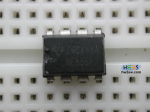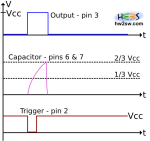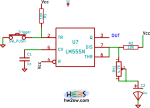
What remains of monostable configuration is the retriggerable mode.
To be concise, the retriggerable version simply gives you the possibility to extend the period of the ON time, that we saw in the previous post fixed by the external components; this is done just by giving a new trigger input while the output is still HIGH.
What happens?
From that input instant a new period starts, and if no other triggering inputs occur, the output signal will continue to stay high for that fixed period of time more.
Because we talked about the necessity to have an input impulse with a duration far quicker than the output one, we assume it as a rule.
Now we must concentrate on the core of the discussion: how to get the signal retriggered.
In other words where we must act to get success.

